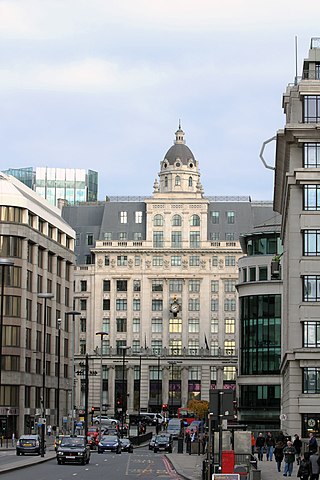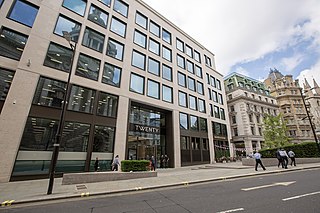
King William Street is a street in the City of London, the historic nucleus and modern financial centre of London. It is a two-way street linking Lombard Street, at its northern end, with London Bridge, which marks the start of the start of the A3 route to Portsmouth.

Friends' Provident Insurance was a banking institution founded in 1832 to serve the needs of the Society of Friends (Quakers). Based in Bradford, Yorkshire, it concentrated on sickness and annuity policies until its life fund acquired Century Insurance in 1918, expanding into general insurance. The restriction to Quaker membership was an increasing constraint but the ties were substantially reduced by the Friends' Provident Institution Act 1915. Although Century's branch network enabled FPI to expand, the periodic underwriting losses strained the life fund's capital base and Century was sold in 1975. In the year 2000, Friends Provident demutualised and listed on the FT100 Index. After abortive takeover negotiations, Friends accepted a takeover bid from Resolution Limited in 2009.

Samuda Brothers was an engineering and ship building firm at Cubitt Town on the Isle of Dogs in London, founded by Jacob and Joseph d'Aguilar Samuda. The site is now occupied by Samuda Estate.

Royal Insurance Holdings plc was a large insurance business originating in Liverpool but based in London from the early 20th century. It merged with Sun Alliance in 1996 to form the Royal & Sun Alliance Insurance Group.

Sir Charles Asgill, 1st Baronet merchant banker, was the third son of Henry Asgill, silkman, of St Clement Danes, Middlesex and was educated at Westminster School.

Commercial Union plc was a large insurance business based in London. It merged with General Accident in 1998 to form CGU plc.

The history of insurance traces the development of the modern business of insurance against risks, especially regarding cargo, property, death, automobile accidents, and medical treatment.

The Eagle Star Insurance Company plc was a leading British insurance business. It underwrote the full range of risks including liability, fire, accident, marine, motor, life, contingency and Pluvius (weather) insurance. It was listed on the London Stock Exchange and was a constituent of the FTSE 100 Index.

The Guardian Assurance Company was a British insurance company based in London and formed in 1821 to offer both life and fire insurance. Through a combination of organic growth and acquisition it became one of the leading insurance companies. It operated as a mutual organization, meaning that it was owned by its policyholders rather than by shareholders. In 1968 it merged with Royal Exchange to form Guardian Royal Exchange.

Phoenix Group Holdings plc is a provider of insurance services based in London, England. It is listed on the London Stock Exchange and is a constituent of the FTSE 100 Index.

John Macvicar Anderson was a Scottish architect.

Sun Alliance Group plc was a large insurance business with its main offices in the City of London and later Horsham. It was created in 1959 by the merger of Sun Insurance, founded in 1710, and Alliance Assurance founded in 1824. In 1996 Sun Alliance merged with Royal Insurance to form the Royal & Sun Alliance Insurance Group.
Peter Finch Martineau was an English businessman and a philanthropist, with particular interest in improving the lives of disadvantaged people through education.

The International Life Assurance Society was a 19th-century British insurance company. Its operations in the United States, particularly in the state of Massachusetts, caused it to play a major role in the development of insurance regulation in that country.
Charles Povey was a British pamphleteer and entrepreneur, who challenged the Royal Mail's postal monopoly by running the "Halfpenny Carriage", a local London postal system similar to William Dockwra's Penny Post. He founded the first joint-stock company for fire insurance, the Exchange House Fire Office later the "Sun Fire Office" that remains in business today as the RSA Insurance Group.
William Lionel Hichens (1874–1940) was a British industrialist, chairman of Cammell Laird from 1910.
Pelican and British Empire Life Insurance Company was a British life insurance company. It was established in 1797 by Phoenix Assurance as the Pelican Life Office, later the Pelican Life Assurance Company, before merging with British Empire Mutual Life Assurance in 1903 to become the Pelican and British Empire Life Insurance Company.
London Assurance was an English insurance company founded in 1720, in the midst of the South Sea Bubble speculation. It was acquired by Sun Alliance in 1965 to form the Sun Alliance and London.
London and Lancashire Insurance was founded in 1862, and had become one of the U.K.'s leading fire insurers by the end of the 19th century. A series of acquisitions in the early 20th century took the company into accident and marine insurance, as well as life assurance, making it a leading composite insurer. Following a period of consolidation in the industry, London and Lancashire was acquired by Royal Insurance in 1962.

The Scottish Amicable Life Assurance Society, commonly known as Scottish Amicable, was founded in Glasgow in 1826 and became the sixth largest mutual life assurance institution in the UK with 1.9 million policy holders in the mid-1990s.















